Level(3) Lambda UDPmon Large Monitor Results
Description
In this document UDP experiments are described that were performed with a
modified version of the UDPmon
package written by R.E. Hughes-Jones in the sense that from
5000 packets the sequence number and the arrival time in microsec. are
specified. The experiments were executed at the
Level(3) Lambda before acceptance by
SURFnet. All tests were performed after
the hosts upgrade of the SARA cluster to
515 Mbyte memory and Linux V.2.4.16-web100.
An overview and description of the tests at the preceding
Teleglobe Lambda can be found in this
document. During those tests the Lambda, the hosts
hardware and OS were in various upgrade states.
The tests, described in the following subsections, were executed. The wait time
between two packets, send by UDPmon, was always
zero sec. The from this package obtained bandwidth are always calculated
from the sequence number and the relative receiving time from the last packet
that arrived without lost at the receiving host.
Tests SARA & EVL
In this section the results between test hosts located at
SARA and
EVL are described. The
SARA hosts were running Linux 2.2.15, and
the EVL hosts Linux 2.4.2.
Host gwgsara5 Directly Connected to the ONS
Setup
The scheme for this tests was:
+--------+ +-+
|gwgsara2|----|S|
+--------+ | | +-+ +-+ +-+
|S|--| | | | | | +------+
+--------+ | | |O| |O| |6|---|prusin|
|gwgsara3|----|R| | |- .... -| | |5| +------+
+--------+ +-+ |N| |N|---|0|
| |- .... -| | |9|--+
+--------+ |S| |S| | | | hardware loop
|gwgsara5|---------| | | | | |--+
+--------+ +-+ +-+ +-+
SARA Chicago
|
Using this scheme tests were performed with the following streams to be able to
notice the differences between the induced paths:
|
Stream
|
Path Properties
|
|
prusin => gwgsara2
|
Use both the SSR 8000 and the LSD 6509.
|
|
prusin => gwgsara5
|
Use only the LSD 6509.
|
|
gwgsara2 => gwgsara5
|
Use both the SSR 8000 and the LSD 6509 with the
loop-back interface.
|
Results
Time-sequence plots
In these tests the receiving time difference with the first packet has been
plotted as a function of the package sequence number for packet sizes of 500,
1000, 1200 and 1460 bytes. In the
these data are shown for the stream prusin =>
gwgsara2, in the
for the stream prusin => gwgsara5, and in the
these data are presented for the stream gwgsara2 =>
gwgsara5
shows for these streams as function of the packet size: 1) the
bandwidth (B) calculated
with ,
from the sequence number at the last received packet without lost (variable
Last_Recv_Seq_Nr) and from the packet size in bytes, 2) the
sequence number of that last received packet without lost, and 3) the
# packets lost.
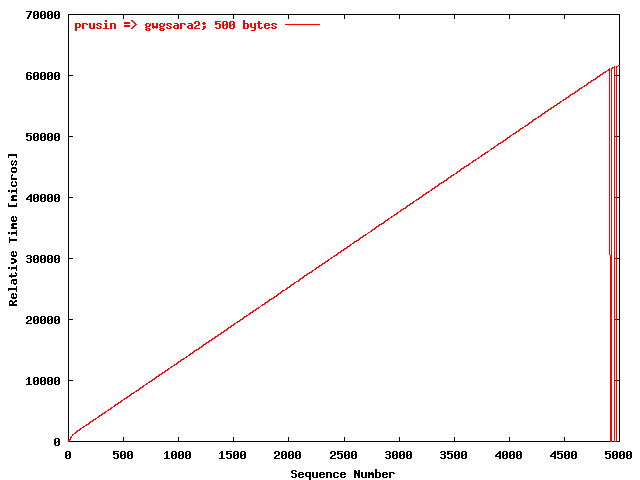
| .I. |
|
The relative receiving time as function of the packet
sequence number for the UDP stream
prusin => gwgsara2 using the
SSR 8000 and the LSD 6509. The packet size was
500 bytes. |
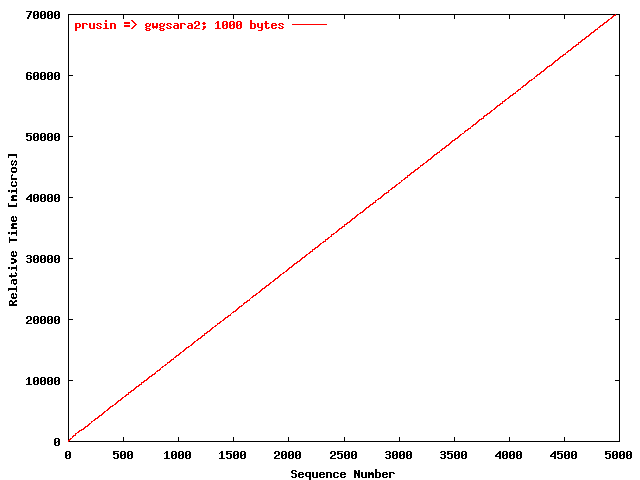
| .II. |
|
The relative receiving time as function of the packet
sequence number for the UDP stream
prusin => gwgsara2 using the
SSR 8000 and the LSD 6509. The packet size was
1000 bytes. |
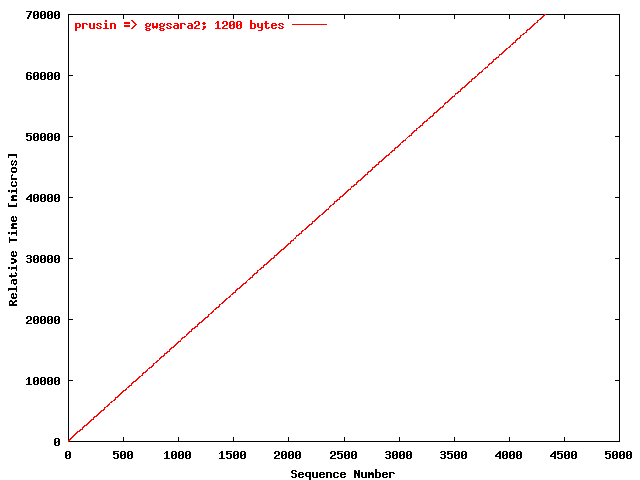
| .III. |
|
The relative receiving time as function of the packet
sequence number for the UDP stream
prusin => gwgsara2 using the
SSR 8000 and the LSD 6509. The packet size was
1200 bytes. |
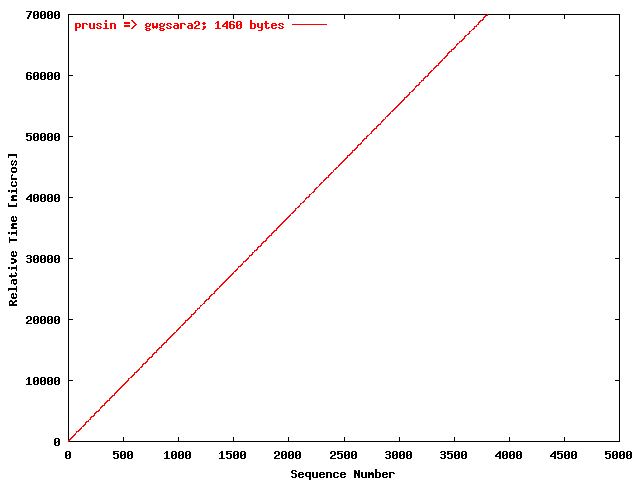
| .IV. |
|
The relative receiving time as function of the packet
sequence number for the UDP stream
prusin => gwgsara2 using the
SSR 8000 and the LSD 6509. The packet size was
1460 bytes. |
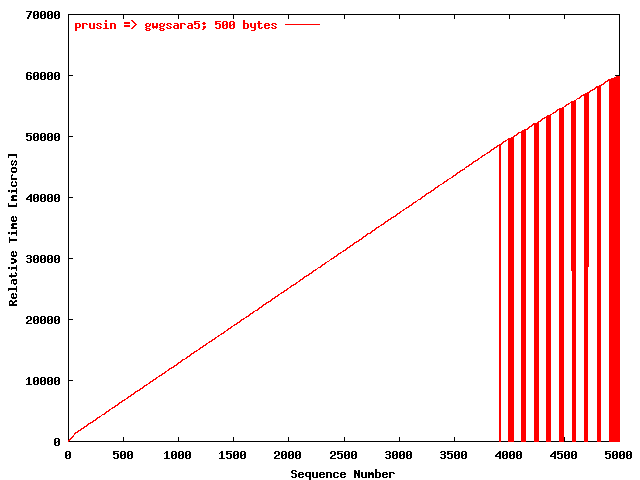
| .I. |
|
The relative receiving time as function of the packet
sequence number for the UDP stream
prusin => gwgsara5 using only
the LSD 6509. The packet size was
500 bytes. |
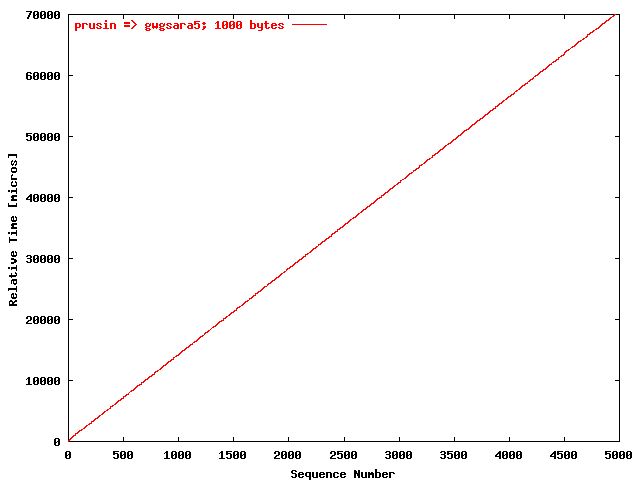
| .II. |
|
The relative receiving time as function of the packet
sequence number for the UDP stream
prusin => gwgsara5 using only
the LSD 6509. The packet size was
1000 bytes. |
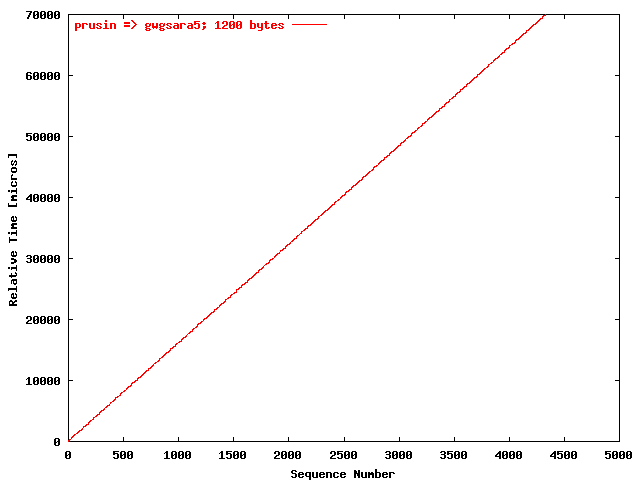
| .III. |
|
The relative receiving time as function of the packet
sequence number for the UDP stream
prusin => gwgsara5 using only
the LSD 6509. The packet size was
1200 bytes. |
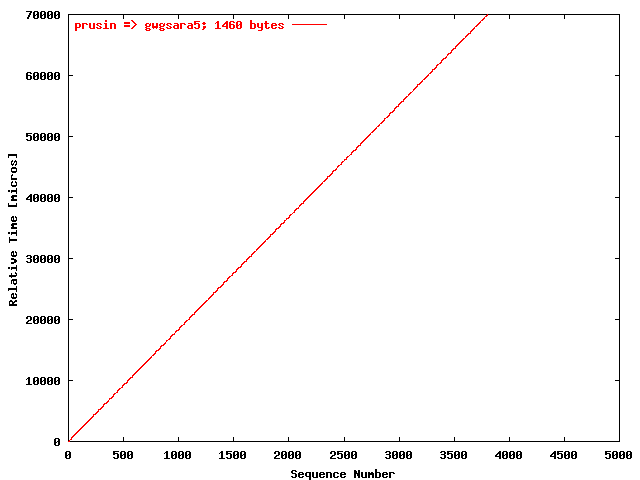
| .IV. |
|
The relative receiving time as function of the packet
sequence number for the UDP stream
prusin => gwgsara5 using only
the LSD 6509. The packet size was
1460 bytes. |
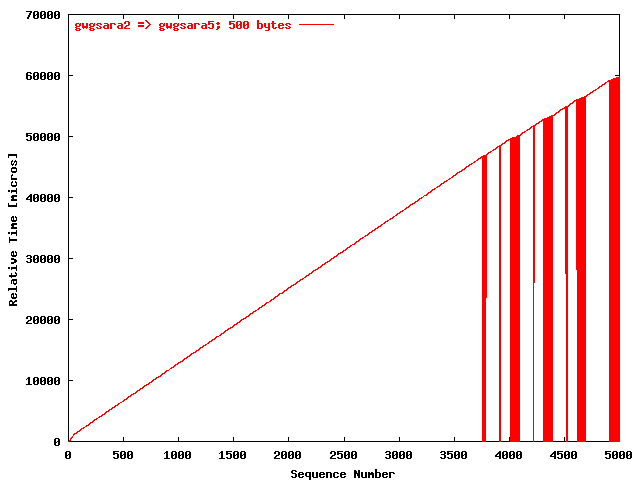
| .I. |
|
The relative receiving time as function of the packet
sequence number for the UDP stream
gwgsara2 => gwgsara5 using the
SSR 8000 and the loop-back at the LSD 6509.
The packet size was 500 bytes. |
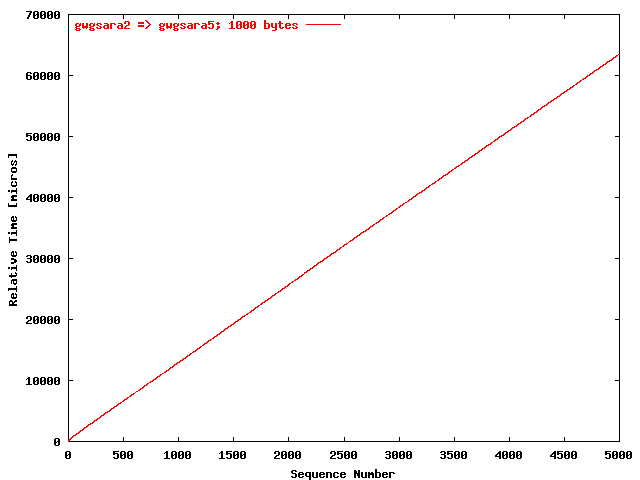
| .II. |
|
The relative receiving time as function of the packet
sequence number for the UDP stream
gwgsara2 => gwgsara5 using the
SSR 8000 and the loop-back at the LSD 6509.
The packet size was 1000 bytes. |
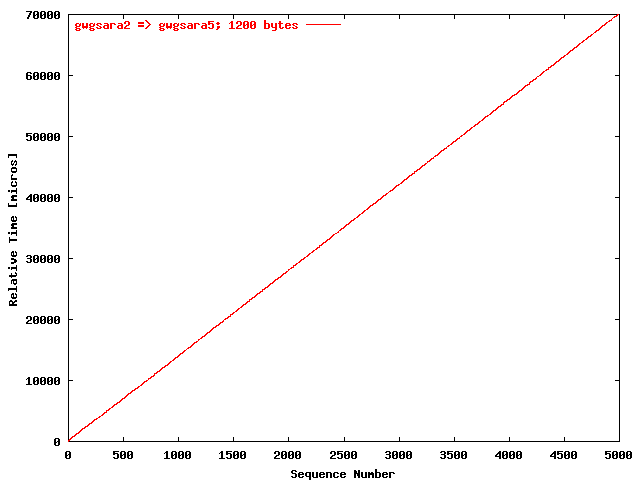
| .III. |
|
The relative receiving time as function of the packet
sequence number for the UDP stream
gwgsara2 => gwgsara5 using the
SSR 8000 and the loop-back at the LSD 6509.
The packet size was 1200 bytes. |
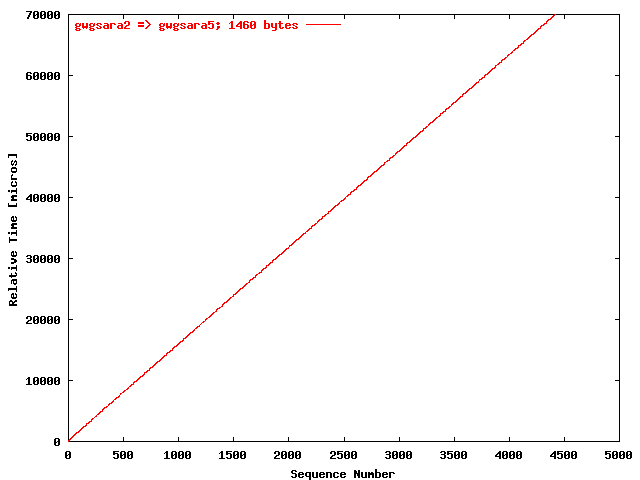
| .IV. |
|
The relative receiving time as function of the packet
sequence number for the UDP stream
gwgsara2 => gwgsara5 using the
SSR 8000 and the loop-back at the LSD 6509.
The packet size was 1460 bytes. |
|
Stream
|
Packet size
[bytes]
|
Bandwidth
[Mbit/S]
|
Last recv.
seq. nr
|
# Packets
lost
|
|
prusin => gwgsara2
|
500 |
322 |
4913 |
33 |
| 1000 |
568 |
4999 |
0 |
| 1200 |
595 |
4999 |
0 |
| 1460 |
635 |
4999 |
0 |
|
prusin => gwgsara5
|
500 |
321 |
3907 |
162 |
| 1000 |
568 |
4999 |
0 |
| 1200 |
594 |
4999 |
0 |
| 1460 |
635 |
4999 |
0 |
|
gwgsara2 => gwgsara5
|
500 |
322 |
3756 |
174 |
| 1000 |
630 |
4999 |
0 |
| 1200 |
684 |
4999 |
0 |
| 1460 |
738 |
4999 |
0 |
| . |
|
The bandwidth calculated
with ,
the last received packet without lost, and the
# packets lost given as a function of the specified
streams and of the packet size. |
Packet size plots
In these tests the UDPmon tool
has been run for a large number of packet sizes, while the other parameters were
unchanged. In the plots, shown below, the following parameters are presented as
a function of the packet size:
-
displays the bandwidth, calculated
with
from the sequence number at the last received packet without lost. The
bandwidth is only calculated when at least 200 packets were received
without lost.
-
presents the sequence number from the last packet that has been received
without any lost.
-
gives the bandwidth calculated from the received packets in the region were
packet lost did occur. The bandwidth is only calculated when at least
200 packets have been received in this region.
-
gives the # packets lost.
In these plots the results for the various streams are presented by separate
plot traces.
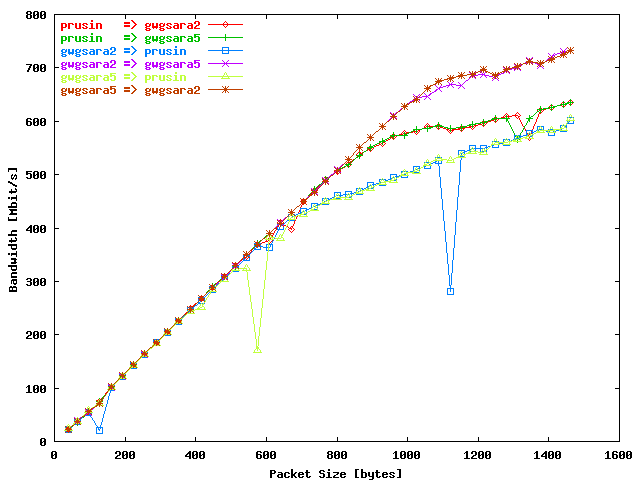
| .I. |
|
The bandwidth from the region without packet lost as
function of the packet size for the streams presented by
the plot traces. |
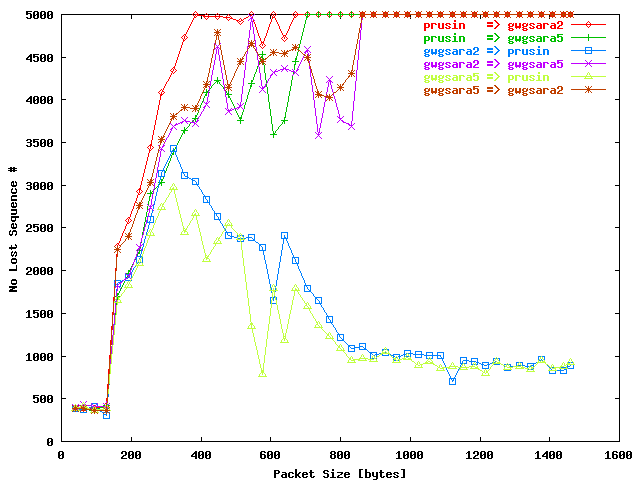
| .II. |
|
The Sequence Number from the last packet without loss
as function of the packet size for the streams presented
by the plot traces. |
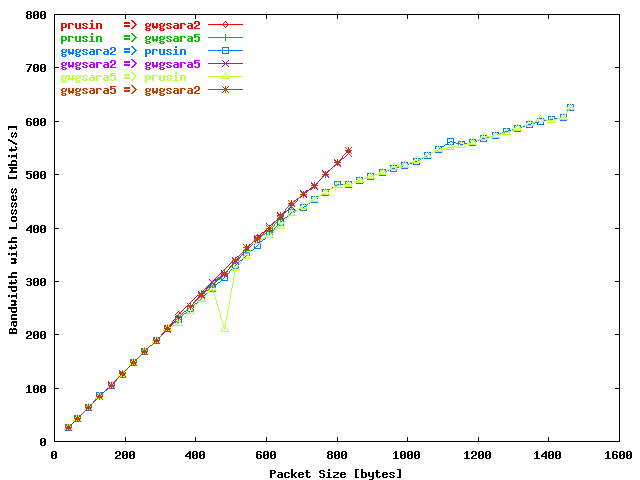
| .III. |
|
The bandwidth in the region with packet loss as
function of the packet size for the streams presented by
the plot traces. |
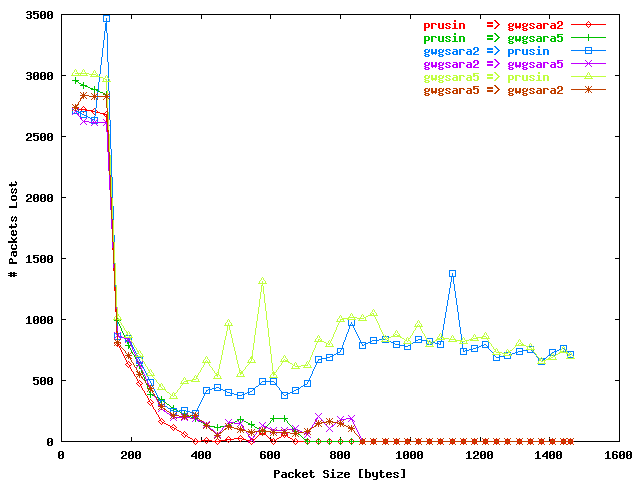
| .IV. |
|
The # packets lost as function of the packet size
for the streams presented by the plot
traces. |
Conclusions
From these results the following conclusions can be drawn:
-
The time-sequence plots can be compared with
corresponding results at the
Teleglobe Lambda described in the
described in the
"UDPmon Monitor Results for Large Configuration" and the
"More SARA & EVL UDPmon Large Results and SNMP". It
appears that the packets lost at the
Level(3) Lambda are considerably less
than with the Teleglobe Lambda,
although it looked like that some bandwidths at the previous
Teleglobe Lambda were higher, which
may also result in higher percentages packets lost, due to host effects.
There also should be realised that the
SARA during the tests at the
Teleglobe Lambda were still
equipped with 128 MB memory and Linux V. 2.2.15 kernels. That also
makes the comparison less reliable.
-
In the plot of the no loss bandwidth as function of the packet size
()
it appears that the bandwidth values for the smaller packet sizes are
linearly increasing as function of the packet size, reflecting that network
properties are dominant in this region. Hereafter host effects become
dominant reflecting in the highest bandwidths in the streams between
SARA hosts, a lower bandwidth for the
streams from EVL hosts to
SARA hosts and the lowest bandwidth in the
reverse direction. This is completely in agreement with the better
performance of the SARA hosts compared
with the EVL hosts.
-
For higher packet sizes the larges # packets lost are found for
streams from SARA hosts to
EVL, also reflecting the
lower performances of the latter hosts.
-
The bandwidth values in the packet loss region
()
are comparable with the bandwidths in the region without loss. This may be
an indication that the losses are not caused by bottlenecks in the network.
-
When the results of the streams from / to gwgsara5 are
compared with those from / to gwgsara2 no large influences of
the SSR 8000 could be observed. That is especially true for the larger
packet size.
v Level(3) Lambda UDPmon Large with STS Tuning |
Teleglobe Lambda UDPmon Large Results















